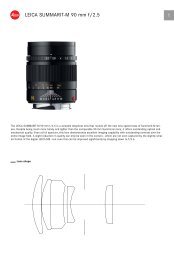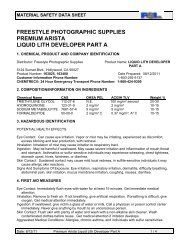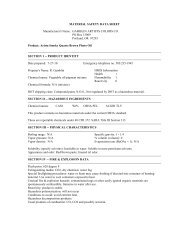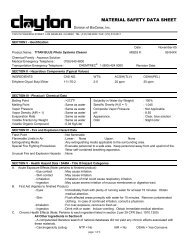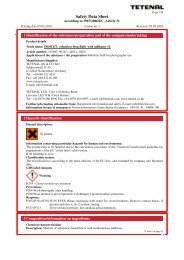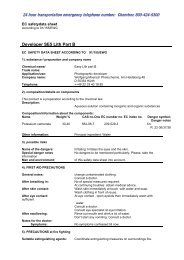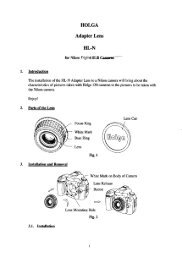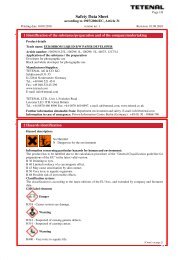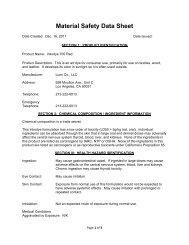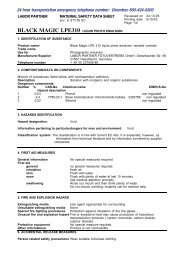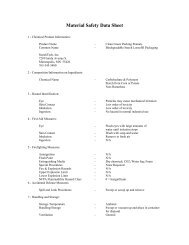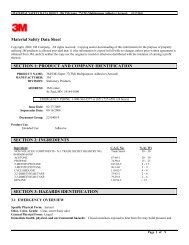Data sheet Moersch Lith developer - Ars-Imago
Data sheet Moersch Lith developer - Ars-Imago
Data sheet Moersch Lith developer - Ars-Imago
Create successful ePaper yourself
Turn your PDF publications into a flip-book with our unique Google optimized e-Paper software.
MOERSCH<br />
SPECIAL EDITION 5 LITH<br />
SE5 has been formulated specially for <strong>Lith</strong> printing. With the two concentrates and additives C & D<br />
(optionally E as shadow area accelerator, grain additive) the optimal working solution for all ‚<strong>Lith</strong>able‘<br />
papers can be mixed. Note: Additives D & E are highly concentrated – dilute 1+4 with water (see<br />
table) before use.<br />
<strong>Lith</strong>able papers are those with Chloro-Bromide emulsions without incorporated development<br />
accelerators such as phenidone. To test whether a paper is lithable carry out the following: Sprinkle<br />
strip of the paper under normal room lighting with the B solution. If nothing happens after 2-3<br />
minutes (or if traces of pink or brown appear) then either it is clean or contains only hydroquinone<br />
and is worth trying. If blacks appear, particularly if they appear suddenly, then a development<br />
accelerator is present which renders the paper useless for lith processing. The only remedy is to try<br />
by thoroughly washing the paper first to remove this component.<br />
Suitable <strong>Lith</strong> papers, listed by difficulty:<br />
Best results, distinctive colouring:<br />
Fomatone/Rollei Vintage 131/132 and all those Forte-Warmtone emulsions such as Polywarmtone<br />
and Fortezo that are still available.<br />
Somewhat less colorful:<br />
Kentmere Kentona with green-black shadows, Fotospeed <strong>Lith</strong> with saturated blacks.<br />
Creamy beige:<br />
Agfa MCC und Adox MCC<br />
Greeny-yellow or reddish yellow highlights, saturated, grainy blacks:<br />
Fotokemika Varikon, Adox Fine Print Classic VC<br />
Brown – red/brown highlights, deep shadows, grainy in the middle tones:<br />
Fotokemika Emaks, Adox Nuance, <strong>Imago</strong> <strong>Lith</strong><br />
Yellow to reddish-yellow highlights, brown/ green-brown shadows:<br />
Kentmere Fineprint Warmtone, Wephota BN112<br />
Difficult to lith, only recommended for experienced <strong>Lith</strong> printers:<br />
Ilford MGWT, Bergger Prestige VCCB<br />
Very grainy, with a distinct tendency to peppercorn:<br />
Fomabrom Fixed grade papers (after 2002) Fomabrom Variant III, Rollei Vintage 111,<br />
Slavich<br />
Working solution preparation:<br />
Example: Fomatone<br />
1000ml Water + 25ml A + 25ml B + 15-20ml D<br />
Before adding D take 100-200ml of <strong>developer</strong> for later use as a regenerator.<br />
If the conventional, non-lith exposure time is not known, the inexperienced user should determine<br />
this time using their usual paper <strong>developer</strong> and with the smallest aperture (because of the<br />
Schwarzschild effect). Note this time and open the aperture 3 stops. The lith developing time is now<br />
expected to be between 6-8 minutes.<br />
Agitate the print continously in the <strong>developer</strong> and take care to ensure the print stays submerged to<br />
avoid dry areas caused by the print floating to the surface. Develop by inspection at least towards the<br />
end. So: emulsion side up, don’t worry about fog and keep the print moving. For a while nothing will
appear to happen. The image will start to appear – with a few exceptions – between two and four<br />
minutes. With high dilutions and high amounts of Bromide the image will take a very, very long time<br />
to develop. This is absolutely necessary in order to maintain many colours (yellow-brown, ochre,<br />
redbrown, pink) as well as tonal differentiation in the highlights. After half the expected development<br />
time has elapsed there should not be any predominant appearance of highlights or shadow<br />
differentiation, the shadow areas should not appear too quickly or the ‚lith-band‘ (areas of<br />
unstructured shadow) will be too broad in the final print.<br />
The image will appear to be flat and weak right up to the end then the semi-quinone kicks in and<br />
starting in the deepest shadows the modulated blacks start to spread, tentatively at first and then<br />
ever rapidly from one Zone to the next. The correct ‘Snatch point’ at which development is arrested<br />
can only be determined by experience. Now’s the time to decide, with some papers, whether it does<br />
in the bin or frame. Finished? Out! Stop bath! Agitate! Don’t stop to let <strong>developer</strong> drip off the paper<br />
– better to renew the stop bath more often.<br />
Increase temperature to 24°C or more speeds up the whole development process without any<br />
detrimental effect upon the result.<br />
The following fundamentals hold true:<br />
The more light, the warmer the highlight and middle tones with a softer gradation. This is conditional<br />
on extended exposure times of over a half of 1 stop, the best match of both <strong>developer</strong>s to the paper<br />
in terms of dilution or by the addition of more Bromide (starter), otherwise the image develops too<br />
quickly with the highlights tapering off before the infectious development of the shadows can get<br />
going. The longer this infectious development is delayed, the more intensive the effect.<br />
Impatient worker can now get going. Those wishing to learn more may read on.<br />
An understanding of the action mechanism is an absolute requirement for fine calibration and<br />
optimum regeneration. A detailed description of the complex processes would exceed the framework<br />
of this introduction (for more information, we recommend Tim Rudman, The Master Photographers<br />
<strong>Lith</strong> Printing Course ISBN 1-902538-02-1), so here only the most important things in brief. The trigger<br />
for the "infectious development" is the formation of semiquinone during the development process.<br />
Semiquinone is an intermediate oxidation product of the development substance hydroquinone, which<br />
is normally "picked up" by the antioxidants (such as sodium sulphite) contained in the <strong>developer</strong>. For<br />
this reason, lith <strong>developer</strong>s cannot contain more than traces of free sulphite, which unfortunately has<br />
adverse effects upon the working life of the solution. The rapid formation of semiquinone in this<br />
<strong>developer</strong> is enhanced by an additive. For that reason, the often-recommended "inoculation" (addition<br />
of used, heavily-oxidized solution) or "maturing" (starting semiquinone production by developing a<br />
strip of exposed paper) of working solutions is not necessarily required; even the first print will be<br />
dependably "lithed". These methods are nevertheless useful for stabilizing the <strong>developer</strong>; otherwise<br />
one cannot count on reproducible results until after the third print has gone through. Barriers of<br />
different levels of effectiveness can be constructed to prevent the semiquinone from kicking in too<br />
soon in the development process. In addition to other restrainers, bromide is generally used in this<br />
regard. It is not able to begin to be effective upon the partially-developed silver molecules until the<br />
semiquinone content of the <strong>developer</strong> has exceeded the predetermined threshold level of the user’s<br />
choice. Then, however, its effect is very sudden, equalling in its effect a second, superadditive<br />
<strong>developer</strong> substance.<br />
<strong>Lith</strong> <strong>developer</strong>s which are severely exhausted, particularly those with extremely high dilutions, reach<br />
the limits of their buffering capacity through acidic oxidation products. Sulphite is used up, alkalinity<br />
falls off, which leads to the situation where the highlights need more light than the semiquinone allows.<br />
An additional difficulty is the increasing amounts of bromide are released from the emulsion. For that<br />
reason, to ensure consistent print results, regular regeneration is required, at least with dilutions<br />
greater than 1+15. Regeneration type and quantity are also dependent upon the paper used.<br />
Normally, regeneration with a working solution of the same dilution (with either zero or reduced<br />
bromide additive) is sufficient. More on this below.<br />
Adding<br />
+ Solution A: harder, more colourful, grainier, slower, shorter working life<br />
+ Solution B: softer, less colourful, faster, longer working life<br />
+ Bromide: delays the onset of the lith effect, requires more light
+ Sulphite: antioxidant and darkening reducer, careful addition to avoid peppercorn<br />
Working life: general specifications regarding lith <strong>developer</strong> working solutions are very misleading!<br />
The following factors have an effect upon working life:<br />
1.) Degree of dilution<br />
2.) Composition: relationship A:B and additives such as sodium sulphite (C)<br />
3.) Amount of use: fresh - used - used up<br />
4.) Oxidation surface: bottle filled to the top or tray filled to the depth of a finger<br />
5.) Developer quantity per oxidation surface<br />
6.) Regeneration<br />
In the formulation of SE5 more emphasis was placed upon having a large number of usable <strong>sheet</strong>s of<br />
paper than upon having an extremely long tray life, the working life can always be enhanced by the<br />
addition of Solution C, if the paper being used permits it.<br />
Example 1: Fomatone 1+10 without sulphite<br />
500 ml tray 8x10 inch without regeneration 5-8 8x10 prints 4 hours<br />
1 litre " " 500 ml total regeneration 12-20 8x10 prints 8 hours<br />
Example 2: Fotokemika Varycon 1+10 with sulphite 20 ml/litre<br />
500 ml tray 8x10 inch without regeneration 5-8 8x10 prints 6 hours<br />
1 litre " " 500 ml total regeneration 12-20 8x10 prints 12 hours<br />
A visual point of reference for the condition of the working solution is the colour. When freshly mixed, it<br />
is clear; as it is used it becomes yellowish to amber in colour. It must be regenerated no later than this<br />
point. When it reaches the point of being reddish-brown, monitoring is difficult; dark red means it’s all<br />
over! Solutions that have been somewhat used (yellow) can be stored for a few days in filled, tightlystoppered<br />
bottles.<br />
Life of the Concentrates:<br />
A full/half-full bottles at least 8/4 years<br />
B full or partially-full bottles: unlimited life<br />
C Sodium Sulphite solution: The 20% Antioxidant contained in the Kit is a stabilised mixture of<br />
different sulphites. In unopened bottles it is fully effective for at least 2 years, in partly full bottles the<br />
effectiveness gradually reduces as a result of slow but continuous oxidisation. This can be avoided by<br />
the use of smaller containers, by squeezing a plastic container to expel the air or by the use of a<br />
neutral gas (Tetenal Protectan) or cigarette lighter gas.<br />
D, E, Ω Starter solution practically unlimited.<br />
Regeneration: In the interest of consistent results, regeneration should be carried out regularly,<br />
starting with the 3 rd -5 th fifth print. The following types of regeneration are possible, depending on the<br />
paper used, as alternatives:<br />
1.) using working solution of the same dilution (using half as much bromide as in the initial<br />
solution), either with 10% of the initial quantity on a regular basis or more on an irregular<br />
basis (during the process if need be, but then gradually adding it, accompanied by<br />
vigorous agitation)<br />
2.) with diluted Solution B, in order to maintain stable pH value (in case the <strong>Lith</strong> Point moves<br />
downward too much) -- don’t overdo it, start with small quantities and monitor effects!<br />
3.) with Solution C: usually 2-5 ml is sufficient; considerable larger quantities are necessary<br />
with some papers in order to avoid peppercorn and "black dots".<br />
TIPS AND TRICKS<br />
Operating temperature: The normal temperature, as always, is 20°C. Temperatures under 18°C are<br />
unsuitable. The <strong>developer</strong> temperature can be raised to 25-28°C to shorten the process times. The<br />
speed savings when going from 20°C to 25°C is 40%. Bromide-rich solutions can be taken up over<br />
25°C, although one must remember that elevating the temperature speeds up all chemical processes,<br />
meaning oxidation as well!
Formaldehyde, which usually appears in lith <strong>developer</strong>s, has been dispensed with in this formula. That<br />
means that there are no unpleasant odours or emission-related health risks to be concerned about,<br />
even at high temperatures.<br />
The temperature of the <strong>developer</strong> can be maintained with some degree consistency at 18-26°C in<br />
cooler rooms when the tray is placed upon 2 bottles filled with warm (30-50°C) water.<br />
Two-bath development: Often the only solution for highlight definition + lith black with high-contrast<br />
negatives and papers with high levels of silver bromide.<br />
Example: first <strong>developer</strong> with high bromide content (highlights hold, shadow areas develop without<br />
lithing), changing into second <strong>developer</strong> without bromide or sulphite, even perhaps with a slight<br />
excess of Solution A (more than 30-60 seconds is rarely necessary).<br />
Toning: <strong>Lith</strong> prints are extremely responsive to toning. Selenium or gold toning (or combinations<br />
thereof) are even often indispensable.<br />
It is undoubtedly selenium toner that offers the greatest variety of possibilities. Depending upon<br />
dilution and exposure time, one can just enhance the shadows or change their tonal colour, or one<br />
can alter all the tonal values in their print colour. Some papers, when lithed with a lot of bromide, show<br />
no maximum black. Selenium performs miracles with these, hard and fast (1+3 to 1+9, 10-30<br />
seconds!).<br />
Hardening: Some papers (particularly those with matte surfaces and factory-fresh emulsions) should<br />
be hardened before toning in aggressive baths such as cyan, sulphur or selenium (less than 1+15)<br />
when subjected to development times over 8 minutes, in order to avoid colouring in the picture<br />
highlights.<br />
Gelatine hardening is possible as a general rule at all stages of the processing procedure:<br />
1.) Hardening before development (alkali hardener): the disadvantage is the effort involved --<br />
every print requires an additional three to four minutes of additional processing time<br />
2.) Hardening additive in stop or fixing bath: advantage: standard-issue hardening additives<br />
on the market; disadvantage: increased water use through considerable prolongation of the<br />
washing time<br />
3.) Hardening after fixing and brief washing with one of the well-known acid solutions, or with<br />
our special lith hardener. Disadvantage: extensive washing must take place once again<br />
before selenium toning, or the acidic paper felt must be neutralized in a washing aid<br />
What else? The OFF switch for the lith effect<br />
If one only wants the glowing colourfulness and finds the lith effect an apparently necessary evil, then<br />
just switch it off! There are two alternative methods available for doing this:<br />
1.) Tiny quantities of any given paper <strong>developer</strong>: because, all the <strong>developer</strong>s to be found on<br />
the market, except for a very few exceptions, contain at least two <strong>developer</strong> substances,<br />
the hydroquinone in the lith <strong>developer</strong> reacts superadditively with at least one additional<br />
<strong>developer</strong> substance and "lithing" is no longer possible. The print colour shifts more or less<br />
strongly in the direction of green.<br />
2.) Large quantity of sodium sulphite: the precisely correct quantity, depending upon the paper<br />
being used, falls between 40% and 200% of the Solution A quantity.<br />
Beautiful brown tones can be created with warm toned papers in particular.<br />
Example: Forte PW: Dilution 1+8 tone brown and 1+15 tone reddish brown<br />
Water 830 + A 60 + B 50 + C 50 Exposure +1 f/stop, development 6 minutes<br />
Water 1600 + A 60 + B 50 + C 50 Exposure +2.5 f/stops, development 10 minutes<br />
Addresses: Wolfgang <strong>Moersch</strong> Photochemie, Am Heideberg 48, 50354 Hürth<br />
Tel. ++49 (0)233 943137 Fax ++49 (0)2233 943138 E-mail wolfgang@moersch-photochemie.com<br />
Internet www.moersch-photochemie.com<br />
Instructions www.moersch-photochemie.com/daten/knowhow.htm




